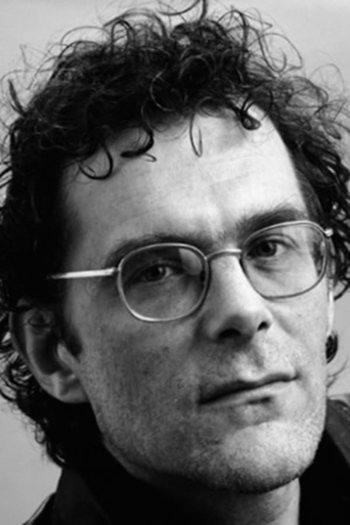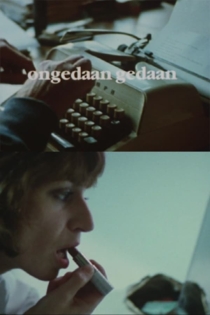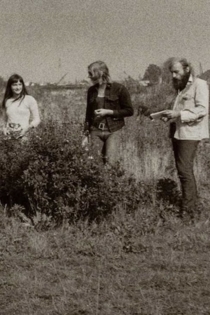
Frans van de Staak
1943 - 2001Kladboekscènes
Frans van de Staak
Michiel Nooter, Marlies Heuer
The film is adapted from a play by Cyrille Offermans Lichtenberg, scenes at the dawn of a new era". Although the protagonist shares some features with the experimental physicist and writer George Christoph Lichtenberg (1742-1799), who wrote the famous Sudelbücher and numerous letters, the film does not pretend any historical accuracy with respect to the real Lichtenberg, but focuses on Offermans' hybrid [partial fictitious] personage. The result is not an interplay between fact and fiction, but a sort of view of Lichtenberg, mouthing some 19th- and 20th- century authors he couldn't have known, strictly speaking, but whose alleged fantastic formulations seem to follow from his own writings in a natural way.
Wastebook scenes

Ongedaan gedaan
Frans van de Staak
Thom Hoffman, Martien van den Ouwelant
Frans van de Staak, Holland's most prominent avant-garde director, made this film "...about people who want to get something done. I leave out the why as well as the results. What's left is the moment of endeavour. There are two couples. The four characters are played by eight actors. There is little dialogue. Sometimes a couple does not seem to live together, just to be alive together in the same room. Each one of them at one time walks through an anymous part of Amsterdam. They put their feet down with a will, clicking their way through town. We do not know where or why they are going. To a meeting, to get some exercise, nowhere? They have difficulty in communicating. They leave notes to each other on the table rather than talk. The film sometimes mocks their intensity. It is surprising that such a strange film can keep the viewer's attention for an hour and a quarter. But it certainly does. (Dutch Fim 1988-89)
Deed Undone

Schijnsel
Frans van de Staak
Bert Luppes, Frieda Pittoors
Every scene of the film comprises a dialogue between a man and a woman. The dialogues are fragmentary, in other words, the dialogue in one scene does not tie in with that of the next. In addition there is no development in the relationship between the actor and the actress towards a happy or unhappy ending. The dialogues are not only of substantial interest; it is above all material for the actors. The film balances on the boundary between portraying an intimate relationship between a woman and a man and the intimacy in the acting between the actor and actress. When an actor or actress hardly has any words in a scene, he or she portrays loneliness; when he/she has a monologue, then the attention is focused on speaking the text, on (the reflection about) being an actor. (Wim Schlebaum
Glint

Lastpak
Frans van de Staak
Marlies Heuer, Betty Schuurman
The protagonist in the film is an actor (René van het Hof) who is acting his life. He is a nuisance, but only for those who have had enough of his play acting or who are ashamed to be around this clown. His wife breaks up with him because she just can't tolerate the man any more and he seems to accept that in an apparently matter-of-fact way. He leaves the city for a cottage in the countryside.
Nuisance

Sepio
Frans van de Staak
Carina Ellemers
Like in his short Ten poems of Hubert Kzn Poot (1975) there is just one protagonist in Sepio. A woman is immersed within a landscape in summertime and she adores her beloved one in everything that emerges from her surroundings.—atelierfransvandestaak.nl
Sepio

De Onvoltooide Tulp
Frans van de Staak
This film is Frans van de Staak's first full feature, for which he wrote 28 scenes and worked with a cast of 29 actors and 29 actresses. Each scene is performed by a male and a female; some scenes are repeated by different actors. Once again he financed this production from his own savings. (Wim Schlebaum)
De Onvoltooide Tulp

Op uw akkertje
Frans van de Staak
The film consists of 43 scenes which are fragments and do not tell a story but may be compared to musical intermezzi - they give the impression that they have been slotted in between other scenes, but the nature of these other scenes is not made clear. (Wim Schlebaum)
Op uw akkertje

Het vertraagde vertrek
Frans van de Staak
Jacq Vogelaar and Frans van de Staak cooperated in a sort of struggle between language and film: their perspectives are different, even exclusive. For Vogelaar his primary preoccupation with language as a novelist is anger, and rebuilding its expression as an individual fixation of the embodied space, whereas for Van de Staak as a filmmaker language is embedded in the activity of making film, which goes beyond any linguistic fixation... "The actor's unintended gestures, manner of moving or change of bodily position, is as important as the text he speaks -all that has to be on the same level of significance, and by doing so it becomes meaningless, because only then it dissolves." No one scene [except the first] 'exists' in advance, fixed in a script, but each scene was created and realized in reaction to a previous scene, which was then screened after its recording. As a result of this 'domino-method' the scenario was written after the making of the film, which took one year.
Het vertraagde vertrek

Uit het werk van Baruch d'Espinoza 1632-1677
Frans van de Staak
From Spinoza's Ethica 82 sentences were selected without a strict coherence and re-assembled in seven components. Each component was filmed four times at least, in a different setting with different actors. Spinoza's sentences are taken as dialogues 'tout court', and not as a collection of opinions. Spinoza's style of philosophical thinking is presented as an activity in the first place, which is then revealed by each individual actor in his own way.
From the Labour of Baruch d'Espinoza

Het Bezoek
Frans van de Staak
A girl visits a place where a boy and another girl stay for a while. Afterwards they all leave. The film was shot in a period of two weeks, with one week of rest in between. Each scheduled day the complete script was played several times again. Such a 'take of the whole script' was only partially shot. [Actually no one of the actors was rehearsed: one learns the text by reading it in action.] This repetition stands in sharp contrast with the fact that the actors and members of the crew create an ad hoc context that never became final. For example: 'this is a visit'. There is an essential correspondence between the situation on the set and the spectator's observation of what happens on the screen later, which is nevertheless also its most distinctive characteristic.
Het Bezoek
